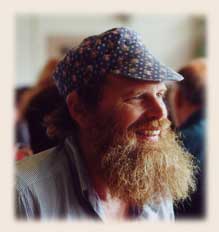| SOIL,
FOOD, & PEOPLE CONFERENCE
March 27-29, 2000
GROW BIOINTENSIVE conference on the U.C. Davis campus
Home
| Intro | Presentations
| Breakout Sessions | Friends:
Old & New | Sponsors
PRESENTATIONS
Passive Solar Greenhouse
Steve Moore
 |
Steve Moore
is a farmer in Pennsylvania and the former director of the Center
for Sustainable Living of Wilson College, where his work included
teaching, research, and management of a large CSA farm. His
future work will continue to develop the use of GROW BIOINTENSIVE
within a passive solar commercial greenhouse. |
Moore and his wife Carol have been farming organically
for 26 years, using horses for the farm work up until last year.
They also had dairy heifers and were raising pigs for market. The
farming operation included a greenhouse. Twelve years ago, needing
more income, they were considering expanding the greenhouse.
But they started being aware of all the gadgets
the greenhouse contained and that it was taking 1,500 gallons of
propane every 10 days to heat it. They realized they were missing
the mark. They changed their operation and since then have been
growing commercially in a passive solar greenhouse, using no fossil
fuel at all.
|
Steve Moore teaches John
Jeavons about the solar greenhouse's effectiveness. |
Instead, the greenhouse retains its warmth with
double-glazing made of multi-year plastic sheeting. At night, an
additional sheet of plastic is currently placed over all the crops
to further hold in heat. Initially, the greenhouse was heated by
a thermophilic (hot) compost pile, but now a more carbon-efficient
mesophilic (warm) pile is used. In addition, the compost pile has
seedling flats placed on top of it and serves as a "heating
table".
At night, this is covered by plastic sheeting
as well. The greenhouse has grown lettuce in an average of 5-week
cycles (rather than the normal 8-week ones experienced by most people)
- except during the three hottest months of the year - with temperatures
dipping as low as -17 degrees Fahrenheit in its southern Pennsylvania
location.
Moore stated that ten years ago they were struggling,
and following the current advice to "get big," they rented
more ground and bought more horses. Then a neighbor lent Moore a
copy of How To Grow More Vegetables. He thought it was good, but
totally impractical. However, he attended one of John Jeavons' Three-Day
Workshops and has become more and more involved with the method.
He has found that the basic precepts of GROW BIOINTENSIVE
growing - improved soil structure, raised permanent beds, increased
organic matter, close spacing and transplanting - all work well
in a passive solar greenhouse.
Moore said they are experimenting with nutrition
and growing most of their own food. They are focusing on extending
the growing season of plants rather than growing out of season.
After 4 years of growing GROW BIOINTENSIVEly, the soil in the greenhouse
now contains 14% organic matter. And this was soil which was compacted
by machinery while the greenhouse was being built.
Moore feels that using transplants gives them
security, because they know they will have plenty of seedlings at
the right time. He mentioned that they use alfalfa in their compost
to minimize the nitrate level accumulation that can happen in greenhouse
growing. And in the 12 years since they have been using an unheated
greenhouse, they have never had a disease problem.
During the warmer weather, hot weather crops,
such as sorghum, peppers, eggplant and onions, are grown - some
of them in troughs hanging from the ceiling of the greenhouse. Peppers
have produced 6.0 to 11.1 times the U.S. average, eggplant 5.0 to
6.9 times, onions 2.0 times and bok choi 7.4 times.
Moore stated that when he left Wilson College
last December, they sold the last of their horses and committed
themselves fully to the GROW BIOINTENSIVE method. He looks on this
as his version of "downsizing."
top |